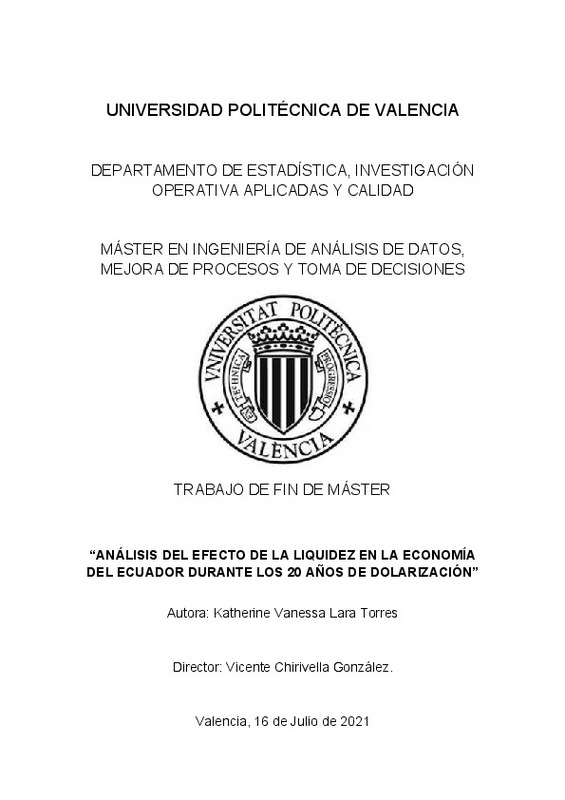|
Resumen:
|
[ES] En el año 2000, la economía ecuatoriana atravesó una profunda crisis, acompañada de inestabilidad económica y financiera. Esta recesión fue generada principalmente, por desequilibrios inflacionarios, la devaluación ...[+]
[ES] En el año 2000, la economía ecuatoriana atravesó una profunda crisis, acompañada de inestabilidad económica y financiera. Esta recesión fue generada principalmente, por desequilibrios inflacionarios, la devaluación de su moneda - el sucre -, y la pérdida de credibilidad y confianza por parte de la población en el sistema financiero nacional. Consecuencia de ello, el gobierno ecuatoriano tomó la decisión de adoptar el dólar estadounidense, como moneda oficial. En este sentido, la presente investigación tiene por objeto analizar la liquidez de la economía ecuatoriana, durante los veinte años de adopción de la dolarización, así como la evolución y los efectos que han surgido en el crecimiento, la inversión y la inflación. Para este estudio se utilizaron modelos ARIMAX que a través del análisis de intervención y efecto calendario permitieron cuantificar el efecto que han tenido en las variables ciertos eventos externos. Adicional, se emplea un Modelo de Vectores Autorregresivos (VAR) para mostrar los efectos en los indicadores macroeconómicos ante un impulso en la liquidez. Los resultados mostraron que el efecto la liquidez incidió positivamente en la inversión y el crecimiento, y que mantiene estable a la inflación. Adicional, se validó la afectación del Covid-19 en las variables macroeconómicas: Producto Interno Bruto, Inversión e Inflación.
Los objetivos específicos del trabajo serían:
¿ Documentar el proceso de dolarización del Ecuador, con el objeto de tener una base que permita explicar los resultados que se obtendrán en este análisis.
¿ Entender el comportamiento de la Liquidez, PIB, Inversión e Inflación, en la economía ecuatoriana a través de un análisis coyuntural, usando modelos ARIMAX, los cuales a través del análisis de intervención y de efecto calendario permiten medir el efecto de una caída o pico de las variables analizadas en un trimestre determinado, así como también la de realizar un pronóstico.
¿ Determinar el efecto conjunto que tiene la liquidez en las variables seleccionadas (inversión, inflación y PIB) por su relevancia económica, utilizando como herramienta de apoyo un modelo de Vectores Autorregresivos (VAR), que permita a través de su análisis impulso¿respuesta, observar la influencia de un cambio de la liquidez en las demás variables macroeconómicas y así validar la afirmación de si la dolarización mantiene estabilidad económica en el país.
[-]
[EN] In 2000, the Ecuadorian economy went through a deep crisis, accompanied by economic and financial instability. This recession was generated mainly by inflationary imbalances, the devaluation of its currency - the sucre ...[+]
[EN] In 2000, the Ecuadorian economy went through a deep crisis, accompanied by economic and financial instability. This recession was generated mainly by inflationary imbalances, the devaluation of its currency - the sucre -, and the loss of credibility and confidence on the part of the population in the national financial system. As a result, the Ecuadorian government made the decision to adopt the US dollar as the official currency. In this sense, the present research aims to analyze the liquidity of the Ecuadorian economy, during the twenty years of adoption of dollarization, as well as the evolution and the effects that have arisen on growth, investment and inflation. For this study, ARIMAX models were used that, through the intervention and calendar effect analysis, made it possible to quantify the effect that certain external events had on the variables. Additionally, a Vector Autoregressive Model (VAR) is used to show the effects on macroeconomic indicators in the face of a boost in liquidity. The results showed that the liquidity effect had a positive impact on investment and growth, and that it keeps inflation stable. Additionally, the impact of Covid-19 in the macroeconomic variables was validated: Gross Domestic Product, Investment and Inflation.
The specific objectives of the work would be:
¿ Document the dollarization process of Ecuador, in order to have a basis that allows explaining the results that will be obtained in this analysis.
¿ Understand the behavior of Liquidity, GDP, Investment and Inflation in the Ecuadorian economy through a conjunctural analysis, using ARIMAX models, which through intervention and calendar effect analysis allow to measure the effect of a fall or peak of the variables analyzed in a given quarter, as well as making a forecast.
¿ Determine the joint effect that liquidity has on the selected variables (investment, inflation and GDP) due to their economic relevance, using an Autoregressive Vector (VAR) model as a support tool, which allows, through its impulse-response analysis, observe the influence of a change in liquidity on the other macroeconomic variables and so validate the statement of whether dollarization maintains economic stability in the country.
[-]
|







